|

Mosaic
pictures can be made from many different types of material. From
the traditional smalti to coloured card cut into shapes. The different
properties offered by these materials means that finished mosaics
can be placed almost anywhere in the world, indoors or out. Below
we list the most common materials used for making mosaics.
Tesserae
is the collective name for the small tiles that when placed close
together go to make up the mosaic picture.
Smalti
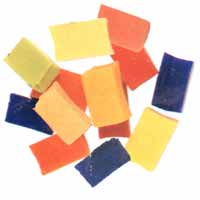 Smalti
is the classic mosaic material. They are thick, rectangular pieces
of opaque glass approximately 10x15x7mm. The glass is coloured with
metallic oxides while molten. They are then allowed to cool into
'pancakes' approximately 31cm in diameter, from which the smalti
is hand cut. This gives it its distinctly irregular surface with
highly reflective powers. Smalti is normally sold in half kilo bags
and by colour grouping. ie. golds, reds, yellows and oranges; whites,
greens and blues; and blacks, greys and browns. Gold and silver
smalti is made by placing silver or 24 carat gold leaf onto a glass
backing and then covering with a thin layer of glass, often coloured.
Again these slabs are hand-cut to various sizes but the common one
is 20x20mm. Because the surface of smalti is pitted it is usually
left ungrouted, so as not to dull the surface by filling in the
holes with grout. The traditional method of pushing smalti into
a bed of prepared mortar is partially self grouting anyway. As smalti
has an uneven surface and pitted body it is not really suitable
for floors, but is ideal on walls and small decorative pieces. Smalti
is the classic mosaic material. They are thick, rectangular pieces
of opaque glass approximately 10x15x7mm. The glass is coloured with
metallic oxides while molten. They are then allowed to cool into
'pancakes' approximately 31cm in diameter, from which the smalti
is hand cut. This gives it its distinctly irregular surface with
highly reflective powers. Smalti is normally sold in half kilo bags
and by colour grouping. ie. golds, reds, yellows and oranges; whites,
greens and blues; and blacks, greys and browns. Gold and silver
smalti is made by placing silver or 24 carat gold leaf onto a glass
backing and then covering with a thin layer of glass, often coloured.
Again these slabs are hand-cut to various sizes but the common one
is 20x20mm. Because the surface of smalti is pitted it is usually
left ungrouted, so as not to dull the surface by filling in the
holes with grout. The traditional method of pushing smalti into
a bed of prepared mortar is partially self grouting anyway. As smalti
has an uneven surface and pitted body it is not really suitable
for floors, but is ideal on walls and small decorative pieces.
Vitreous
Glass
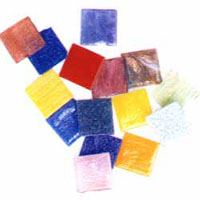 Vitreous
tiles are made from square glass of a uniform size and shape. The
molten glass is poured into trays shaped like waffle irons and then
pressed to give a flat upper surface. The reverse surface is bevelled
and corrugated to give good adhesion. Because the edges are bevelled
these tiles are ideal for use on three dimensional work as they
allow the material to curve naturally. Vitreous glass offers the
widest choice of colours. It is a lot cheaper than smalti and easier
to cut. Virtually indestructable and frost proof it is an ideal
medium for outside use. The flat upper surface makes it suitable
for reverse working, ie. table tops and flat floors. The most commonly
used size is 20x20mm and just under 1kg will cover approximately
30 sq.cm. Vitreous
tiles are made from square glass of a uniform size and shape. The
molten glass is poured into trays shaped like waffle irons and then
pressed to give a flat upper surface. The reverse surface is bevelled
and corrugated to give good adhesion. Because the edges are bevelled
these tiles are ideal for use on three dimensional work as they
allow the material to curve naturally. Vitreous glass offers the
widest choice of colours. It is a lot cheaper than smalti and easier
to cut. Virtually indestructable and frost proof it is an ideal
medium for outside use. The flat upper surface makes it suitable
for reverse working, ie. table tops and flat floors. The most commonly
used size is 20x20mm and just under 1kg will cover approximately
30 sq.cm.
Ceramics
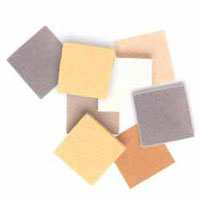 Ceramics
encompass a wide range of materials that you can use. Available
in a huge range of glazed and unglazed surfaces, ceramics represent
what is possibly the most versatile of mediums. Kitchen and bathroom
tiles are are available in many sizes and shapes and their colours
range from soft pastels to full blown primary colours. Some are
even made to represent stone and other natural finishes.Glazed tiles
have a thin coat of colour on a white base, where as unglazed tiles
have colour all the way through. This makes them very useful as
they can be used however you want. Objects such as old vases, dinnerware
and bowls offer another source of tile. By breaking them into random
sizes or cutting by hand into specific shapes they can produce highly
textured surfaces with interesting and sometimes humorous designs.
It is not usually frost-proof, so is not always suitable for outdoors
use. Ceramics
encompass a wide range of materials that you can use. Available
in a huge range of glazed and unglazed surfaces, ceramics represent
what is possibly the most versatile of mediums. Kitchen and bathroom
tiles are are available in many sizes and shapes and their colours
range from soft pastels to full blown primary colours. Some are
even made to represent stone and other natural finishes.Glazed tiles
have a thin coat of colour on a white base, where as unglazed tiles
have colour all the way through. This makes them very useful as
they can be used however you want. Objects such as old vases, dinnerware
and bowls offer another source of tile. By breaking them into random
sizes or cutting by hand into specific shapes they can produce highly
textured surfaces with interesting and sometimes humorous designs.
It is not usually frost-proof, so is not always suitable for outdoors
use.
Pebbles
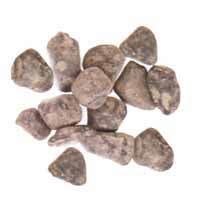 Stone
used to be the main material used for making mosaics, starting with
the pebbles used by the Greeks thousands of of years ago. Pebbles
are still used today but only by a few artists. As far as we know
pebbles are not available commercially, but rely on the artist gathering
a modest collection while walking along the beach or riverbank.
The colour of the pebbles will depend on the geology of the area
you are collecting them in. Mixed with other types of stone stunning
mosaics can be made. Stone
used to be the main material used for making mosaics, starting with
the pebbles used by the Greeks thousands of of years ago. Pebbles
are still used today but only by a few artists. As far as we know
pebbles are not available commercially, but rely on the artist gathering
a modest collection while walking along the beach or riverbank.
The colour of the pebbles will depend on the geology of the area
you are collecting them in. Mixed with other types of stone stunning
mosaics can be made.
Marble
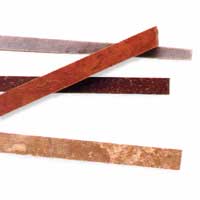 In
the past many mosaics were made from marble and different local
stones. Because of the varying tones and colours in a single sheet
of marble it has a unique and varied interest. For years now marble
has been used on floors, but it can also be used on walls. It is
normally a thick material and one disadvantage of this is weight,
which can make it tricky to fix securely in place. It is expensive
but not as expensive as smalti, and can be obtained in a number
of finishes. Marble can be polished to a glassy finish and in this
way is generally supplied in small blocks known as cubes. Honed
marble is polished, but stopped short of a glassy finish. This allows
the colour of the stone to shine through but produces a matt surface,
giving it a more natural appearance. In
the past many mosaics were made from marble and different local
stones. Because of the varying tones and colours in a single sheet
of marble it has a unique and varied interest. For years now marble
has been used on floors, but it can also be used on walls. It is
normally a thick material and one disadvantage of this is weight,
which can make it tricky to fix securely in place. It is expensive
but not as expensive as smalti, and can be obtained in a number
of finishes. Marble can be polished to a glassy finish and in this
way is generally supplied in small blocks known as cubes. Honed
marble is polished, but stopped short of a glassy finish. This allows
the colour of the stone to shine through but produces a matt surface,
giving it a more natural appearance.
|




 Smalti
is the classic mosaic material. They are thick, rectangular pieces
of opaque glass approximately 10x15x7mm. The glass is coloured with
metallic oxides while molten. They are then allowed to cool into
'pancakes' approximately 31cm in diameter, from which the smalti
is hand cut. This gives it its distinctly irregular surface with
highly reflective powers. Smalti is normally sold in half kilo bags
and by colour grouping. ie. golds, reds, yellows and oranges; whites,
greens and blues; and blacks, greys and browns. Gold and silver
smalti is made by placing silver or 24 carat gold leaf onto a glass
backing and then covering with a thin layer of glass, often coloured.
Again these slabs are hand-cut to various sizes but the common one
is 20x20mm. Because the surface of smalti is pitted it is usually
left ungrouted, so as not to dull the surface by filling in the
holes with grout. The traditional method of pushing smalti into
a bed of prepared mortar is partially self grouting anyway. As smalti
has an uneven surface and pitted body it is not really suitable
for floors, but is ideal on walls and small decorative pieces.
Smalti
is the classic mosaic material. They are thick, rectangular pieces
of opaque glass approximately 10x15x7mm. The glass is coloured with
metallic oxides while molten. They are then allowed to cool into
'pancakes' approximately 31cm in diameter, from which the smalti
is hand cut. This gives it its distinctly irregular surface with
highly reflective powers. Smalti is normally sold in half kilo bags
and by colour grouping. ie. golds, reds, yellows and oranges; whites,
greens and blues; and blacks, greys and browns. Gold and silver
smalti is made by placing silver or 24 carat gold leaf onto a glass
backing and then covering with a thin layer of glass, often coloured.
Again these slabs are hand-cut to various sizes but the common one
is 20x20mm. Because the surface of smalti is pitted it is usually
left ungrouted, so as not to dull the surface by filling in the
holes with grout. The traditional method of pushing smalti into
a bed of prepared mortar is partially self grouting anyway. As smalti
has an uneven surface and pitted body it is not really suitable
for floors, but is ideal on walls and small decorative pieces. Vitreous
tiles are made from square glass of a uniform size and shape. The
molten glass is poured into trays shaped like waffle irons and then
pressed to give a flat upper surface. The reverse surface is bevelled
and corrugated to give good adhesion. Because the edges are bevelled
these tiles are ideal for use on three dimensional work as they
allow the material to curve naturally. Vitreous glass offers the
widest choice of colours. It is a lot cheaper than smalti and easier
to cut. Virtually indestructable and frost proof it is an ideal
medium for outside use. The flat upper surface makes it suitable
for reverse working, ie. table tops and flat floors. The most commonly
used size is 20x20mm and just under 1kg will cover approximately
30 sq.cm.
Vitreous
tiles are made from square glass of a uniform size and shape. The
molten glass is poured into trays shaped like waffle irons and then
pressed to give a flat upper surface. The reverse surface is bevelled
and corrugated to give good adhesion. Because the edges are bevelled
these tiles are ideal for use on three dimensional work as they
allow the material to curve naturally. Vitreous glass offers the
widest choice of colours. It is a lot cheaper than smalti and easier
to cut. Virtually indestructable and frost proof it is an ideal
medium for outside use. The flat upper surface makes it suitable
for reverse working, ie. table tops and flat floors. The most commonly
used size is 20x20mm and just under 1kg will cover approximately
30 sq.cm. Ceramics
encompass a wide range of materials that you can use. Available
in a huge range of glazed and unglazed surfaces, ceramics represent
what is possibly the most versatile of mediums. Kitchen and bathroom
tiles are are available in many sizes and shapes and their colours
range from soft pastels to full blown primary colours. Some are
even made to represent stone and other natural finishes.Glazed tiles
have a thin coat of colour on a white base, where as unglazed tiles
have colour all the way through. This makes them very useful as
they can be used however you want. Objects such as old vases, dinnerware
and bowls offer another source of tile. By breaking them into random
sizes or cutting by hand into specific shapes they can produce highly
textured surfaces with interesting and sometimes humorous designs.
It is not usually frost-proof, so is not always suitable for outdoors
use.
Ceramics
encompass a wide range of materials that you can use. Available
in a huge range of glazed and unglazed surfaces, ceramics represent
what is possibly the most versatile of mediums. Kitchen and bathroom
tiles are are available in many sizes and shapes and their colours
range from soft pastels to full blown primary colours. Some are
even made to represent stone and other natural finishes.Glazed tiles
have a thin coat of colour on a white base, where as unglazed tiles
have colour all the way through. This makes them very useful as
they can be used however you want. Objects such as old vases, dinnerware
and bowls offer another source of tile. By breaking them into random
sizes or cutting by hand into specific shapes they can produce highly
textured surfaces with interesting and sometimes humorous designs.
It is not usually frost-proof, so is not always suitable for outdoors
use. Stone
used to be the main material used for making mosaics, starting with
the pebbles used by the Greeks thousands of of years ago. Pebbles
are still used today but only by a few artists. As far as we know
pebbles are not available commercially, but rely on the artist gathering
a modest collection while walking along the beach or riverbank.
The colour of the pebbles will depend on the geology of the area
you are collecting them in. Mixed with other types of stone stunning
mosaics can be made.
Stone
used to be the main material used for making mosaics, starting with
the pebbles used by the Greeks thousands of of years ago. Pebbles
are still used today but only by a few artists. As far as we know
pebbles are not available commercially, but rely on the artist gathering
a modest collection while walking along the beach or riverbank.
The colour of the pebbles will depend on the geology of the area
you are collecting them in. Mixed with other types of stone stunning
mosaics can be made. In
the past many mosaics were made from marble and different local
stones. Because of the varying tones and colours in a single sheet
of marble it has a unique and varied interest. For years now marble
has been used on floors, but it can also be used on walls. It is
normally a thick material and one disadvantage of this is weight,
which can make it tricky to fix securely in place. It is expensive
but not as expensive as smalti, and can be obtained in a number
of finishes. Marble can be polished to a glassy finish and in this
way is generally supplied in small blocks known as cubes. Honed
marble is polished, but stopped short of a glassy finish. This allows
the colour of the stone to shine through but produces a matt surface,
giving it a more natural appearance.
In
the past many mosaics were made from marble and different local
stones. Because of the varying tones and colours in a single sheet
of marble it has a unique and varied interest. For years now marble
has been used on floors, but it can also be used on walls. It is
normally a thick material and one disadvantage of this is weight,
which can make it tricky to fix securely in place. It is expensive
but not as expensive as smalti, and can be obtained in a number
of finishes. Marble can be polished to a glassy finish and in this
way is generally supplied in small blocks known as cubes. Honed
marble is polished, but stopped short of a glassy finish. This allows
the colour of the stone to shine through but produces a matt surface,
giving it a more natural appearance.